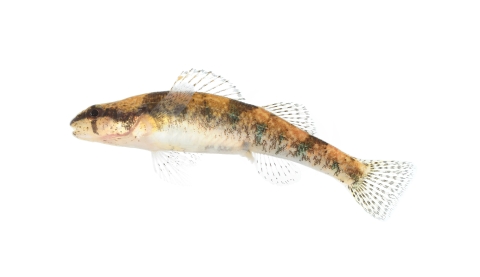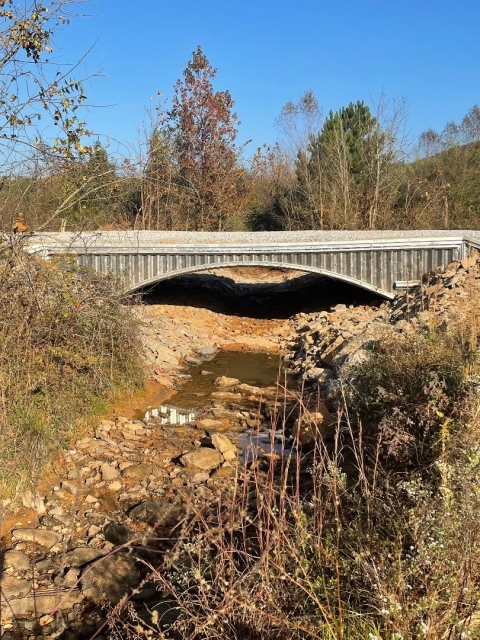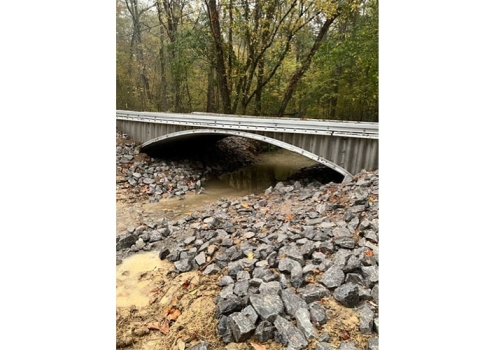The team’s geared up. The coolers are packed. Parents have their stadium seats and spirit gear. The cheerleaders are pumped for the big game. Families of little leaguers in Springville, Alabama, are ready for the first pitch or kick off – until it rains.
Each year, approximately 2,000 kids and their families use the athletic fields at the Springville sports complex, except when they can’t because storms wash out the fields. Flooded conditions delay or cancel games, disappoint little league athletes and cause a lot of work and expense for the city’s parks and rec department.
Turns out, a little fish that darts around on the bottom of the creek eating insects could save the game. The trispot darter helps make everyone a winner, including the fish and Springville’s youth.
“Little Canoe Creek and associated tributaries are home to the trispot darter, a fish that is federally listed as threatened,” said Doug Morrison, manager of Springville’s Big Canoe Creek Nature Preserve, who worked closely with U.S. Fish and Wildlife Service biologists to confirm the fish were in the waterways on the sports complex. “It is important for their survival to have safe fish passage fish passage
Fish passage is the ability of fish or other aquatic species to move freely throughout their life to find food, reproduce, and complete their natural migration cycles. Millions of barriers to fish passage across the country are fragmenting habitat and leading to species declines. The U.S. Fish and Wildlife Service's National Fish Passage Program is working to reconnect watersheds to benefit both wildlife and people.
Learn more about fish passage and clean water.”
Once considered nonexistent in Alabama, biologists are always thrilled to document the trispot darter in Little Canoe Creek. The Left Prong of Little Canoe Creek runs through Springville’s 70-acre little league sports complex. Discovery of the trispot darter there was the first recorded occurrence in this part of the watershed.
Unfortunately, the species's urban habitat in the heart of the city was in trouble due to a collapsed culvert. The culvert altered the stream’s natural flow, limited the fish’s passage and increased flooding on the fields. In addition, the collapsed culvert and the deteriorating roadway allowed more sediment to reach the stream which impacted water quality.
Replacing it would be costly. The city repaired flooded fields several times, so resources were stretched. Once the trispot darter was confirmed, though, the U.S. Fish and Wildlife Service stepped up to bat. The wildlife agency tapped Bipartisan Infrastructure Law Bipartisan Infrastructure Law
The Bipartisan Infrastructure Law (BIL) is a once-in-a-generation investment in the nation’s infrastructure and economic competitiveness. We were directly appropriated $455 million over five years in BIL funds for programs related to the President’s America the Beautiful initiative.
Learn more about Bipartisan Infrastructure Law (BIL) money to help restore the culvert, creek and ballfields.
“BIL funding enables the Service to work with local communities and landowners to address barriers to fish passage – and quickly,” said Lee Holt, a biologist with the Service’s Partners for Fish and Wildlife Program. “Leveraging BIL and other monies allows conservationists to take on more projects that benefit federally listed species, their habitats and the public.”
BIL paid for the replacement of the old culvert with a new, environmentally friendly bottomless arch-shaped culvert. The new structure restores the Left Prong of Little Canoe Creek to its natural, free-flowing state; enhances fish passage; and improves water quality. It also helps protect six athletic fields for soccer, football, softball and baseball from flooding.
BIL freed up money from the city and conservation partners for other projects, including stream bank restorations and sediment controls at the sports complex. Once all projects are complete, walking trails will weave through the complex, and parents will be able to drive safely from field to field, a plus if they have kids playing on separate fields at the same time.
“The Bipartisan Infrastructure Law and the National Fish Passage Program funding were utilized in a way to positively impact our community significantly,” said Rick Hopkins, Springville’s parks and rec director. “The city has spent thousands of dollars repairing flood damage. The project is important because the bottomless arch culvert is the first of many steps for environmental education within our community and partnerships with like-minded agencies.”
When both the city and the Service realized the impact the deteriorating culvert had on the environment and community, they explored ways to work together.
“Important projects like this can get done in a way that can mutually benefit our natural resources, community growth, and future generations,” Holt said. “It all starts with individuals like the city’s Doug Morrison, Mayor Dave Thomas and other great partners who are willing to work with the U.S. Fish and Wildlife Service to establish and build great partnerships.”
Springville and the Service make a winning combo. The team effort protects the trispot darter and creates better conditions to play ball, not just now but in the future.
Most of the sports programs are growing 10-20 percent per season. The sports complex includes tennis courts and is the home field for Springville High School. A disc golf facility is in the works.
“The partnership with the Springville is huge and could be a model for other communities by showing how the federal government can work alongside a local government, state, or city to remedy issues,” said Morrison who has worked closely with the Service for more than a decade.







